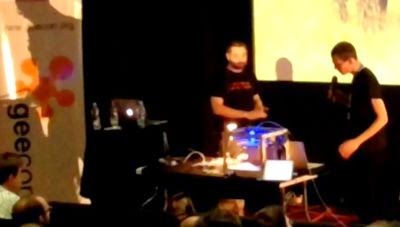Although latest and greatest themes in Java world these days are reactive programming, alternative languages, HTML5 and microservices, I decided to stay close to the ground at first. I chose jBMP presentation to get an update on how thinggus are moving in the old Java enterprise waters.
jBMP looks like a vivid yet mature project and it is promisingly evolving under the RedHat umbrella. In fact, the team have a strategy to focus on knowledge, business goals, their visibility and continuous improvement. Does that ring a bell? To me, that sounds quite close to what agile principles adhere to.
OK, enough business, we all want some fun too, right? And the next presentation certainly was about how to make fun and even conquer the world with home-made devices. Guys, thank you for bringing the real 3D printer there! It was really a great introduction for a beginner to see how the thing looks like and how it works.
 |
| The real 600€ 3D printer on the scene. A wooden skeleton with a machinery visible from outside. |
Some toolset around 3D printers:
- 3D editors like blender, tinkercad
- a slicer (Cura, Repetier-Host) providing more or less a functionality of missing 3D printing dialog
- and not to forget a taft spray - very handy "tool" to improve performance of a printer when the bed is not heated, no kidding
To let the fun continue, I switched then to the latest and greatest trends. Microservices, here I come! The idea to cut a huge system into small and focused microservices is easy to grasp. Knowing when such architecture really helps and how to design it properly is still dark waters for me. Speakers from a company based in Ostrava came to present their approach and experiences. Well, big European mobile operators under the pressure of the market tend to provide constant flow of change requests. To meet their requirements, microservices architecture seems to be a perfect match . Such systems can be maintained in distributed manner, components redeployed separately in different time-frames, failures don't pull the whole system down. Obvious drawback - transactions are hard to manage across multiple services. But as Neal pointed out, maintaining transactions can be really slow and inefficient. Designing operations as idempotent might come to the rescue - how many times have you checked an already locked door just to be sure? Certainly many times and it didn't cost much.
Later I found out why, oh my, why that app server eats so much RAM after I redeploy my applications and that there is Plumbr to aid in searching for mem leaks. Yes, classloading is really tricky even in memory consumption.
Simple rule noted down: always unregister classes you publish to anything on the app server's classpath. For the rest, almighty restart might be cheaper than the time spent on seeking leaks.
Dukescript then steered my course even deeper into the juicy modern stuff. Another attempt to bring Java everywhere, even if compiled to Javascript. Is it still Java then? Well, it seems it passes the duck test: the source code is Java, it executes in JVM, all the tooling of Java works with it. But.
The GUI is based on omnipresent HTML5, meaning that no JavaFX nor Swing components are available. Also, under the hood, the runtime obviously varies according to what different platforms have to offer - JVM where available, otherwise Dalvik on Android, RoboVM on iOS, BackToBrowser Javascript VM in modern browsers. Yes, I wrote Javascript VM. Java can really be executed even in a browser without any plugin, just plain Javascript. I have seen it working so it must be true! It still takes some time to download 2MB of scripts, but wait, this is still an unoptimized proof of concept, which already works well! It is another hit nailing Javascript to become an assembler of the web.
No more time to mention Erlang, Go, Rust, Scala, Kotlin nor Java 8. Luckily Bruce Eckel had a wonderful closing speech about all of them. Even more, he mentioned the driving forces that lead people to design new languages. Better support for parallelism, readability, even purity in design are among them. But purism proved not to be very helpful and mostly did not work. Software transactional memory has not grown to be really usable concept as well. On the other hand, inherent support of parallelism becomes a valuable selling point of modern languages, like Erlang. Even Java 8 has now support for parallel streams. Though, Java 8 stays way too boring. Maybe "Thinking in Kotlin" will be the next book by Bruce Eckel? Anyway, after all that hassle, Python stays Bruce's favourite language - no wonder, more than 20% women in the active community are and will stay another great selling point. Applause to Mr. Eckel for his insights and thank you for reading!